不定式作定语
动词不定式作定语
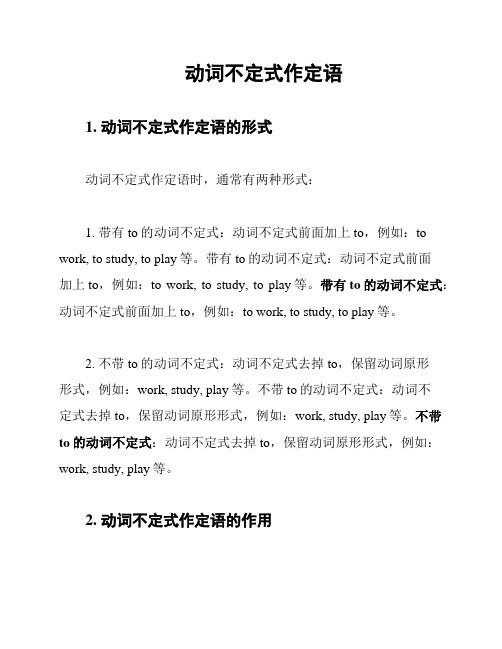
动词不定式作定语1. 动词不定式作定语的形式动词不定式作定语时,通常有两种形式:1. 带有to的动词不定式:动词不定式前面加上to,例如:to work, to study, to play等。
带有to的动词不定式:动词不定式前面加上to,例如:to work, to study, to play等。
带有to的动词不定式:动词不定式前面加上to,例如:to work, to study, to play等。
2. 不带to的动词不定式:动词不定式去掉to,保留动词原形形式,例如:work, study, play等。
不带to的动词不定式:动词不定式去掉to,保留动词原形形式,例如:work, study, play等。
不带to的动词不定式:动词不定式去掉to,保留动词原形形式,例如:work, study, play等。
2. 动词不定式作定语的作用动词不定式作定语时,可以表示被修饰名词或代词的用途、目的、原因等。
例如:- I have a book to read. (我有一本书可以读。
)to read. (我有一本书可以读。
)to read. (我有一本书可以读。
)- She needs a pen to write. (她需要一支笔用来写字。
)to write. (她需要一支笔用来写字。
)to write. (她需要一支笔用来写字。
) - He has an ___ friend. (他有一个约会是去见他的朋友。
)to meet his friend. (他有一个约会是去见他的朋友。
)to meet his friend. (他有一个约会是去见他的朋友。
)3. 动词不定式作定语的位置动词不定式作定语时,通常放在被修饰的名词或代词之后。
例如:- The book to read is on the table. (可读的书在桌子上。
)to read is on the table. (可读的书在桌子上。
动词不定式做定语

动词不定式作定语指的是to do放在名词或者代词后面作后置定语。
翻译:.....的某物;去做某事的.....。
1. 常接动词不定式作后置定语的名词有:time、ability、chance、opportunity、way、courage、plan等例句:I need time to order my thoughts.我需要时间梳理一下思路。
Cycling is a cheap way to get around.骑自行车是一种省钱的旅游方式。
The exhibition gives local artists an opportunity to display their work. 这次展览为当地艺术家提供了展示自己作品的机会。
Is there a plan to work out this?是否打算解决这个问题呢?It takes courage to say what you think.说出你的想法需要勇气。
2. 当名词前面有序数词后置最高级形式的时候,后面常常用动词不定式作定语;例句:He is the first man to come.他是第一个来的人。
He'd always be the first person to offer to help.他总是第一个主动提出帮忙。
He was the last man to blame.他是最不应该受到责备的人。
3. 名词前面有enough、very、only修饰的时候,后面常常接动词不定式;例句:There is enough room to place the piano.这里有足够的空间可以放置这架钢琴。
There isn't enough room to hold so many people.这没有足够的地方容纳这么多人。
There is enough room to hold these people to have a meeting.有足够的地方容下这些人开会。
不定式作定语的三种情况
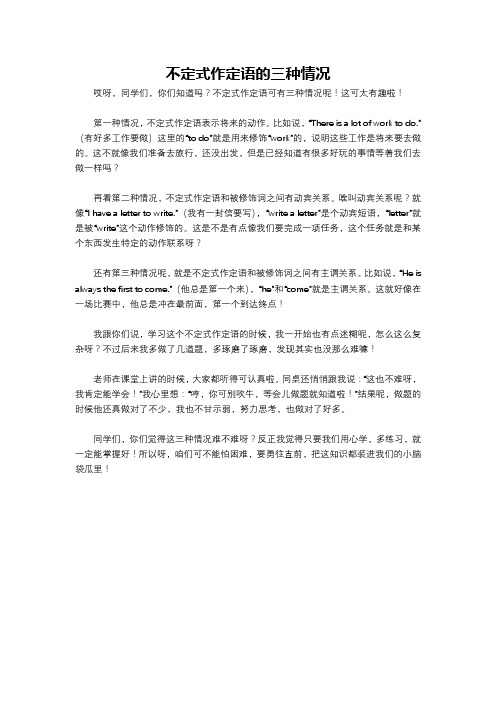
不定式作定语的三种情况哎呀,同学们,你们知道吗?不定式作定语可有三种情况呢!这可太有趣啦!第一种情况,不定式作定语表示将来的动作。
比如说,“There is a lot of work to do.”(有好多工作要做)这里的“to do”就是用来修饰“work”的,说明这些工作是将来要去做的。
这不就像我们准备去旅行,还没出发,但是已经知道有很多好玩的事情等着我们去做一样吗?再看第二种情况,不定式作定语和被修饰词之间有动宾关系。
啥叫动宾关系呢?就像“I have a letter to write.”(我有一封信要写),“write a letter”是个动宾短语,“letter”就是被“write”这个动作修饰的。
这是不是有点像我们要完成一项任务,这个任务就是和某个东西发生特定的动作联系呀?还有第三种情况呢,就是不定式作定语和被修饰词之间有主谓关系。
比如说,“He is always the first to come.”(他总是第一个来),“he”和“come”就是主谓关系。
这就好像在一场比赛中,他总是冲在最前面,第一个到达终点!我跟你们说,学习这个不定式作定语的时候,我一开始也有点迷糊呢,怎么这么复杂呀?不过后来我多做了几道题,多琢磨了琢磨,发现其实也没那么难嘛!老师在课堂上讲的时候,大家都听得可认真啦。
同桌还悄悄跟我说:“这也不难呀,我肯定能学会!”我心里想:“哼,你可别吹牛,等会儿做题就知道啦!”结果呢,做题的时候他还真做对了不少,我也不甘示弱,努力思考,也做对了好多。
同学们,你们觉得这三种情况难不难呀?反正我觉得只要我们用心学,多练习,就一定能掌握好!所以呀,咱们可不能怕困难,要勇往直前,把这知识都装进我们的小脑袋瓜里!。
不定式做定语

不定式做定语1.名词或者代词前有序数词、形容词最高级修饰时,或者被修饰的中心词是序数词、形容词最高级时,常用不定式作后置定语。
It was the first play to win all three of these major awards.它是赢得所有这三项大奖的第一部戏He was the last guest to arrive.(主谓关系)他是最后一个来的客人。
2.被修饰词前有the only,the very,the next等词后用不定式作定语。
The next thing to do is to relax yourself completely(动宾关系)下一步要做的事情是完全放松你自己。
3.抽象名词time, way, ability ,reason ,chance, courage, opportunity等后常用不定式作定语。
I had a chance to visit the Great Wall last month.(同位关系)上个月我有一个机会游览了长城。
4.不定代词something,nothing,little等后常用不定式作定语。
I have something important to tell you.(动宾关系)我有重要的事要告诉你。
Do you have anything else to say?(动宾关系)你还有其他的要说的吗?I have a lot of work to do.(动宾关系)我有很多工作要做。
5.作定语的不定式如果是不及物动词,不定式后面就要有必要的介词。
Give me a pen to write with.(动宾关系)6.如果不定式所表示的动作不是由主语发出,则不定式应使用被动语态。
The airport to be completed next year will help promote tourism inthis area.(动宾关系)下一年即将竣工的飞机场将有助于提升这个地区的旅游业。
不定式作定语

1、I have no house to live in.
2、He has no pen to write with.
(四)同位关系(主表关系):不定式修饰的是抽象名词(如:way,method,chance,opportunity,ability,effort,decision,determination,hope,wish)且不定式说明这个名词的内容。不定式具有名词功能在句中充当同位语。相当于一个由从属连词that引导的同位语从句。其类似用法有动名词作定语(表示用途、作用、分类),而分词无此类用法(分词只具有形容词和副词的功能,而不具有名词的功能)。
3、I get permission to see the President. 我得到允许去见总统。 →I get permission that I can see the President.
不定式作后置定语与它修饰的词有四种关系:
(一)主谓关系:被修饰名词前有序数词(如the first,the second),形容词最高级或the only,the last,the next修饰时,被修饰名词和不定式具有逻辑主谓关系。不定式具有形容词的功能在句中充当定语。相当于关系代词在从句中作主语的定语从句。其类似用法有现在分词作定语。
例如:
1、Please give me something to eat.
2、He has a lot of question to ask.
(三)介宾关系(动状关系):被修饰词如果是不定式里动词的状语,应多用介词短语。由于被修饰词前没有介词,所以只能在不定式里的动词后加介词。不定式具有形容词功能在句中充当定语。相当于关系副词在从句中作状语的定语从句。其类似用法有过去分词作定语(需要加上相应的介词)。
动词不定式作定语 不定式作后置定语

动词不定式作定语不定式作后置定语不定式做定语讲解①不定式作定语,修饰the first,the lost,the third,中心词为不定式的执行者时用to do sth(主动式),中心词为不定式承受者时用to be done(被动式.He was the man to think of the plan to plant trees.The newspaper reporter was the last to walk out of the cave.They found the last child to be injured in the accident.This is the third question to be discussed.②中心词是由动词派生的名词,原动词+不定式作宾语,wish, decision, refusal, arrangement, intention, agreement, hope, need, plan, promise, failure ,attempt They made a decision to put off the meeting until next week.He expressed his wish to visit the Great Wall.He made a promise to be a good boy.There is no need to build a dam on the small river.③中心词是由形容词派生来的,原形容词常用不定式作状语,ability, eagerness, anxiety, patience, willingness.A good teacher must have the ability to make himself understood.④名词本身是抽象名词,不定式解释其中的内容,chance,plan ,means , courage, efforts, measures, movement, opportunity, power, reason, right ,skill, strength, struggle, idea ,way 这时,不定式可以换成of + doing。
不定式短语作定语什么时候用主动什么时候用被动形式
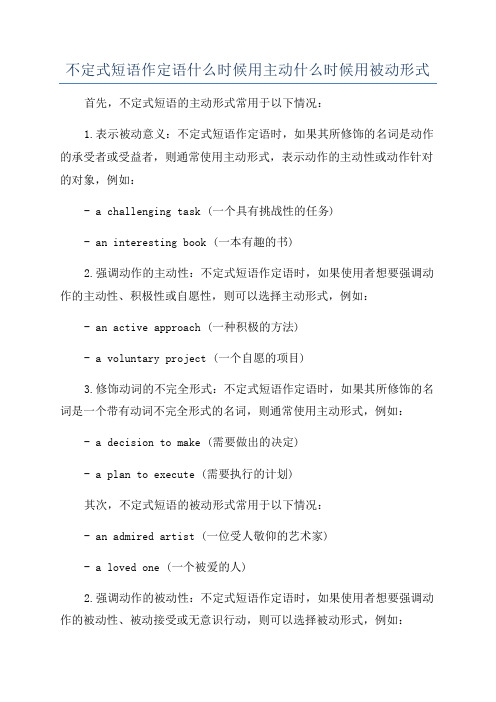
不定式短语作定语什么时候用主动什么时候用被动形式首先,不定式短语的主动形式常用于以下情况:1.表示被动意义:不定式短语作定语时,如果其所修饰的名词是动作的承受者或受益者,则通常使用主动形式,表示动作的主动性或动作针对的对象,例如:- a challenging task (一个具有挑战性的任务)- an interesting book (一本有趣的书)2.强调动作的主动性:不定式短语作定语时,如果使用者想要强调动作的主动性、积极性或自愿性,则可以选择主动形式,例如:- an active approach (一种积极的方法)- a voluntary project (一个自愿的项目)3.修饰动词的不完全形式:不定式短语作定语时,如果其所修饰的名词是一个带有动词不完全形式的名词,则通常使用主动形式,例如:- a decision to make (需要做出的决定)- a plan to execute (需要执行的计划)其次,不定式短语的被动形式常用于以下情况:- an admired artist (一位受人敬仰的艺术家)- a loved one (一个被爱的人)2.强调动作的被动性:不定式短语作定语时,如果使用者想要强调动作的被动性、被动接受或无意识行动,则可以选择被动形式,例如:- a forgotten memory (一个被遗忘的记忆)- a lost key (一个丢失的钥匙)需要注意的是,有些不定式短语可以同时使用主动形式和被动形式,意思上并无太大区别,例如:- a decision to be made / a decision to make (需要做出的决定)最后,需要根据具体的语境、句子结构以及修饰名词的意义来确定不定式短语的主动形式或被动形式。
在写作中,除了遵循以上原则外,还应根据特定语法要求和表达需要进行选择。
高中英语语法讲义:不定式作定语和状语用法归纳
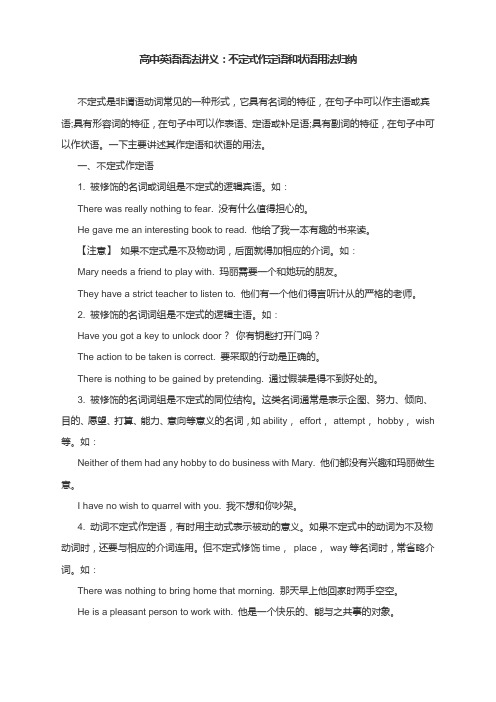
高中英语语法讲义:不定式作定语和状语用法归纳不定式是非谓语动词常见的一种形式,它具有名词的特征,在句子中可以作主语或宾语;具有形容词的特征,在句子中可以作表语、定语或补足语;具有副词的特征,在句子中可以作状语。
一下主要讲述其作定语和状语的用法。
一、不定式作定语1. 被修饰的名词或词组是不定式的逻辑宾语。
如:There was really nothing to fear. 没有什么值得担心的。
He gave me an interesting book to read. 他给了我一本有趣的书来读。
【注意】如果不定式是不及物动词,后面就得加相应的介词。
如:Mary needs a friend to play with. 玛丽需要一个和她玩的朋友。
They have a strict teacher to listen to. 他们有一个他们得言听计从的严格的老师。
2. 被修饰的名词词组是不定式的逻辑主语。
如:Have you got a key to unlock door?你有钥匙打开门吗?The action to be taken is correct. 要采取的行动是正确的。
There is nothing to be gained by pretending. 通过假装是得不到好处的。
3. 被修饰的名词词组是不定式的同位结构。
这类名词通常是表示企图、努力、倾向、目的、愿望、打算、能力、意向等意义的名词,如ability,effort,attempt,hobby,wish 等。
如:Neither of them had any hobby to do business with Mary. 他们都没有兴趣和玛丽做生意。
I have no wish to quarrel with you. 我不想和你吵架。
4. 动词不定式作定语,有时用主动式表示被动的意义。
如果不定式中的动词为不及物动词时,还要与相应的介词连用。
不定式作定语的5种类型

It's a way to solve the problem.
"to solve the problem" 是 "way" 的前置定语,表示“解决问题的方法”。
3. 动词不定式作同位语(解释说明)
不定式与名词或代词并列,进一步解释或说明该名词或代词
He is a man to rely on.
"to rely on" 是 "赖的人”。
4. 动词不定式作补足语(表目的或意图)
不定式作为补足语,与形容词、名词等结合,表示目的或意图
The book is meant to teach children.
"to teach children" 是 "book" 的补足语,表示“这本书的目的是教孩子”。
5. 动词不定式作状语(表示时间、条件、方式等)
不定式作为状语,表示时间、条件、方式等,与句子主语或谓语有逻辑联系
I came to see if you were home.
"to see if you were home" 是状语,表示“我来看看你是否在家”。
不定式作定语的5种类型
类型
特征
示例
解释
1. 动词不定式作后置定语(简单形式)
不定式位于名词或代词之后,表示目的、原因、结果等
I have a dream to become a doctor.
"to become a doctor" 是 "dream" 的后置定语,表示“成为医生的梦想”。
2. 动词不定式作前置定语(复合形式,带介词)
动词不定式作后置定语的用法总结

动词不定式作后置定语的用法总结一、不定式作后置定语的基本结构1. 不定式作后置定语时,通常紧跟在被修饰的名词或代词后面,构成主谓宾结构。
例如:我有很多事情要做。
2. 不定式可以由"to"加动词原形构成,也可以省略"to"。
例如:I have some work to do. 或 I have some work that needs doing.3. 不定式一般不受主语的人称和数的限制。
例如:We have something to discuss. 或 They have a problem to solve.二、不定式作后置定语的句型分析1. 主动不定式:表示被修饰的名词或代词的动作是由它所指代的人或物发出的。
例如:She is a girl to admire.(她是一个值得钦佩的女孩。
)2. 被动不定式:表示被修饰的名词或代词本身所承受的动作。
例如:There are many problems to be solved.(有许多问题待解决。
)3. 完成式不定式:表达在不定式动作发生之前已经发生的动作。
例如:He has a lot of work to have done.(他有很多工作是已经做完的。
)三、不定式作后置定语的语法功能1. 修饰名词或代词,充当后置定语,进一步说明其性质、特征或属性。
2. 说明被修饰名词或代词的用途、目的、原因或结果。
3. 表示被修饰名词或代词的动作或状态。
四、不定式作后置定语的一些注意事项1. 不定式作后置定语时,一般需放在被修饰名词或代词的后面,形成定语从句。
2. 不定式作后置定语要和被修饰的名词或代词保持一致,包括数、人称和性质。
3. 不定式作后置定语要注意使用时态的变化,通常受上下文的语境所限制。
结语动词不定式作后置定语在英语中是一个非常常见的句式结构,它丰富了句子的表达方式,使句子更具表现力和丰富度。
了解和掌握不定式作后置定语的用法,对于提高英语写作能力和阅读理解能力都有着非常重要的意义。
不定式作定语3种情况

不定式作定语3种情况不定式作定语情况:1、被修饰成分在意义上是动词不定式表示的动作的执行者时,作定语用的动词不定式的动词可以是不及物动词,如果是及物动词,动词要带宾语。
2、被修饰成分在意义上是动词不定式表示的动作的承受者时,作定语用的动词不定式的动词应是及物动词,如果是不及物动词,其后必须补加相应的介词。
3、被修饰成分在意义上既不是动词不定式所表示的动作的执行者,也不是动词不定式表示的动作的承受者时,作定语用的动词不定式(短语)比较灵活,既可以是不及物动词,也可以是及物动词加宾语构成的动词短语。
定语的用法1、单词作定语考点1)形容词性物主代词作定语。
如:my bag,her friends. 2)名词作定语。
名词单数作定语。
如:an apple tree,some apple trees. 3)名词复数所有格作定语。
如:a two days’holidays= a two-day holiday= a holiday of two days. 4)表性别时随着被修饰词的单复数改变而改变。
如:a woman teacher,some women teachers.特别提醒:clothes, sport 做定语的时候,必须用复数形式。
比如:sports meeting, sports news, sports shoes, clothes shop等。
2、介词短语作定语考点重点考of,with,in以及方位介词引导的介词短语。
例如:the importance of learning English学习英语的重要性;the tea with milk加奶的茶;the man in blue穿蓝色衣服的男人;the map on the wall 墙上的地图等。
3、动词作定语考点动词作定语主要考不定式,现在分词,过去分词,考点如下:1)不定式作定语,大家要记住三种情况。
一个是放在被不定代词或被the first/next/only/last等修饰名词后面。
不定式作定语表示
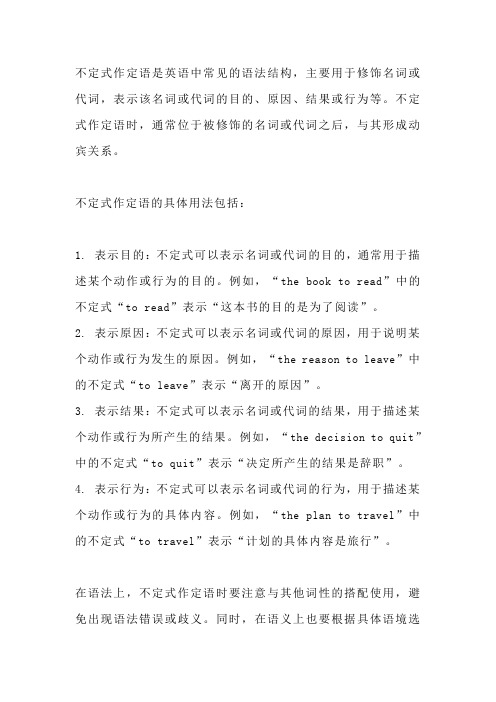
不定式作定语是英语中常见的语法结构,主要用于修饰名词或代词,表示该名词或代词的目的、原因、结果或行为等。
不定式作定语时,通常位于被修饰的名词或代词之后,与其形成动宾关系。
不定式作定语的具体用法包括:
1. 表示目的:不定式可以表示名词或代词的目的,通常用于描述某个动作或行为的目的。
例如,“the book to read”中的不定式“to read”表示“这本书的目的是为了阅读”。
2. 表示原因:不定式可以表示名词或代词的原因,用于说明某个动作或行为发生的原因。
例如,“the reason to leave”中的不定式“to leave”表示“离开的原因”。
3. 表示结果:不定式可以表示名词或代词的结果,用于描述某个动作或行为所产生的结果。
例如,“the decision to quit”中的不定式“to quit”表示“决定所产生的结果是辞职”。
4. 表示行为:不定式可以表示名词或代词的行为,用于描述某个动作或行为的具体内容。
例如,“the plan to travel”中的不定式“to travel”表示“计划的具体内容是旅行”。
在语法上,不定式作定语时要注意与其他词性的搭配使用,避免出现语法错误或歧义。
同时,在语义上也要根据具体语境选
择合适的动词形式,以准确地表达名词或代词的目的、原因、结果或行为等。
总之,不定式作定语是英语中一种重要的语法结构,能够丰富语言表达方式,使句子更加准确、生动。
不定式作定语3种情况例句

不定式作定语3种情况例句(1)定语从句引导的不定式:例句:他是一位博学多闻的人,擅长于探索未知的东西。
(2)用于表语的不定式:例句:他的主要任务就是保证和调和良好的关系。
(3)作定语的不定式:例句:他在志愿者活动中,尽了最大的努力去帮助那些需要帮助的人。
不定式作定语是指动词不定式修饰名词、代词、副词或整个主句,代替一个表示某种属性或特征的形容词。
它常用在形容词短语或介词短语之后,强调句子成分的作用。
下面就来看看不定式作定语的具体用法。
一、定语从句引导的不定式相比较于定语从句引导的动词,定语从句引导的不定式可以代表一系列动作,而不仅仅是表示一个抽象想法。
它可以放在形容词性物主代词之后,用以修饰这个物主代词,以突出它的某些特征。
此外,它还可以用来修饰名词,强调定甴自身的某些能力或职责。
例如:1)He is a man of great learning and skill in exploring things unknown.他是一位博学多闻的人,擅长于探索未知的东西。
2)Her chief task is that of keeping and maintaining good relations. 她的主要任务就是保证和调和良好的关系。
二、用于表语的不定式不定式作表语的用法也很普遍,它表示句子的主语所具有的责任、义务或动作。
例如:1)His duty is to enforce the law. 他的职责是执行法律。
2)His job was to build bridges. 他的任务是建造桥梁。
三、作定语的不定式作定语的不定式经常出现在一些表示能力或能耐的名词后,表达的是句子的主语的能力。
例如:1)He has a talent for singing. 他有歌唱的才能。
2)He is a man of great strength. 他拥有强壮的体魄。
3)He devoted himself to helping those in need in his voluntary activities. 他在志愿者活动中,尽了最大的努力去帮助那些需要帮助的人。
不定式作定语

不定式作定语不定式作定语,一般都是作后置定语,修饰前面的名词或代词。
一、不定式与所修饰词之间的关系1.主谓关系被修饰的名词或代词实际上是不定式的逻辑主语。
如:XXX to help with the work.(someone will help with the work)我们需要有人来帮忙干这工作。
2.动宾关系被修饰的名词或代词是动词不定式的逻辑宾语。
如:I have many letters to write.(to write many letters)我有许多信要写。
3.同位关系不定式与所修饰的名词指的是一回事。
如:We have made a plan to learn from Lei Feng.我们制定了一个向雷锋研究的计划。
4.状语关系被修饰的名词实际上表示动词不定式动作的方式、时间等。
这些名词多是抽象名词。
如:That's the way to do it.那样做才对。
I have no time to go there.我没有时间去那儿。
2、不定式与其所润饰的词组成逻辑上的动宾干系,而该不定式为不及物动词时,厥后须加上恰当的介词,组成及物动词短语。
如:I am looking for a room to live in.我正在找一间房子住。
I need a piece of paper to write on.我需要一张写字用的纸。
There is nothing to worry about.没甚么可忧郁的。
不定式作定语且所修饰的名词是time,place或way时,不定式后的介词一般要省去。
如:He had no money and no place to live.他没有钱也没有地方住。
三、当不定式修饰的名词或代词为不定式动作的承受者时,不定式主动形式与被动形式的含义有所不同。
试对比:There is nothing to do.无事可做。
(有"无聊感")There is nothing to be done.不能做什么了。
不定式短语作定语
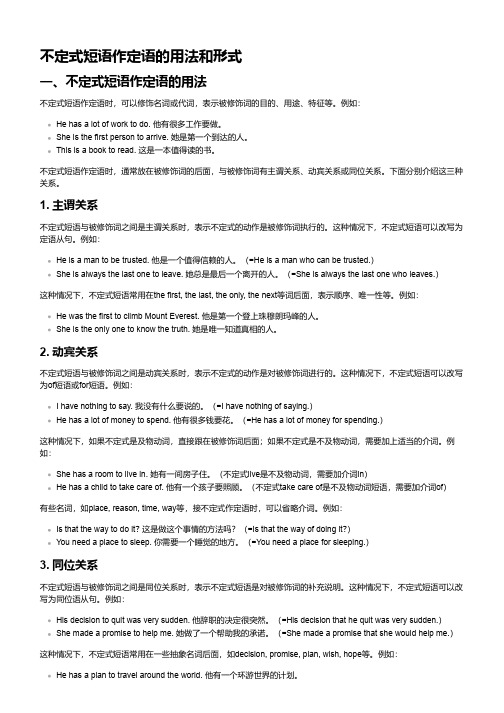
不定式短语作定语的用法和形式一、不定式短语作定语的用法不定式短语作定语时,可以修饰名词或代词,表示被修饰词的目的、用途、特征等。
例如:He has a lot of work to do. 他有很多工作要做。
She is the first person to arrive. 她是第一个到达的人。
This is a book to read. 这是一本值得读的书。
不定式短语作定语时,通常放在被修饰词的后面,与被修饰词有主谓关系、动宾关系或同位关系。
下面分别介绍这三种关系。
1. 主谓关系不定式短语与被修饰词之间是主谓关系时,表示不定式的动作是被修饰词执行的。
这种情况下,不定式短语可以改写为定语从句。
例如:He is a man to be trusted. 他是一个值得信赖的人。
(=He is a man who can be trusted.)She is always the last one to leave. 她总是最后一个离开的人。
(=She is always the last one who leaves.)这种情况下,不定式短语常用在the first, the last, the only, the next等词后面,表示顺序、唯一性等。
例如:He was the first to climb Mount Everest. 他是第一个登上珠穆朗玛峰的人。
She is the only one to know the truth. 她是唯一知道真相的人。
2. 动宾关系不定式短语与被修饰词之间是动宾关系时,表示不定式的动作是对被修饰词进行的。
这种情况下,不定式短语可以改写为of短语或for短语。
例如:I have nothing to say. 我没有什么要说的。
(=I have nothing of saying.)He has a lot of money to spend. 他有很多钱要花。
不定式短语作定语什么时候用主动什么时候用被动形式
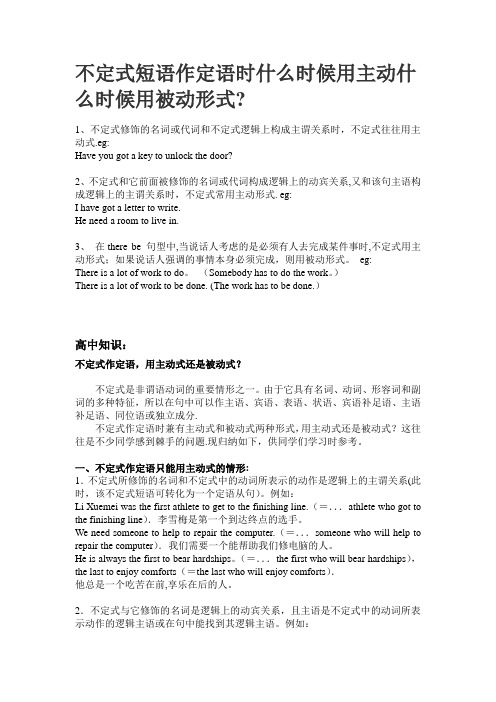
不定式短语作定语时什么时候用主动什么时候用被动形式?1、不定式修饰的名词或代词和不定式逻辑上构成主谓关系时,不定式往往用主动式.eg:Have you got a key to unlock the door?2、不定式和它前面被修饰的名词或代词构成逻辑上的动宾关系,又和该句主语构成逻辑上的主谓关系时,不定式常用主动形式. eg:I have got a letter to write.He need a room to live in.3、在there be 句型中,当说话人考虑的是必须有人去完成某件事时,不定式用主动形式;如果说话人强调的事情本身必须完成,则用被动形式。
eg:There is a lot of work to do。
(Somebody has to do the work。
)There is a lot of work to be done. (The work has to be done.)高中知识:不定式作定语,用主动式还是被动式?不定式是非谓语动词的重要情形之一。
由于它具有名词、动词、形容词和副词的多种特征,所以在句中可以作主语、宾语、表语、状语、宾语补足语、主语补足语、同位语或独立成分.不定式作定语时兼有主动式和被动式两种形式,用主动式还是被动式?这往往是不少同学感到棘手的问题.现归纳如下,供同学们学习时参考。
一、不定式作定语只能用主动式的情形:1.不定式所修饰的名词和不定式中的动词所表示的动作是逻辑上的主谓关系(此时,该不定式短语可转化为一个定语从句)。
例如:Li Xuemei was the first athlete to get to the finishing line.(=...athlete who got to the finishing line).李雪梅是第一个到达终点的选手。
We need someone to help to repair the computer.(=...someone who will help to repair the computer).我们需要一个能帮助我们修电脑的人。
不定式做后置定语
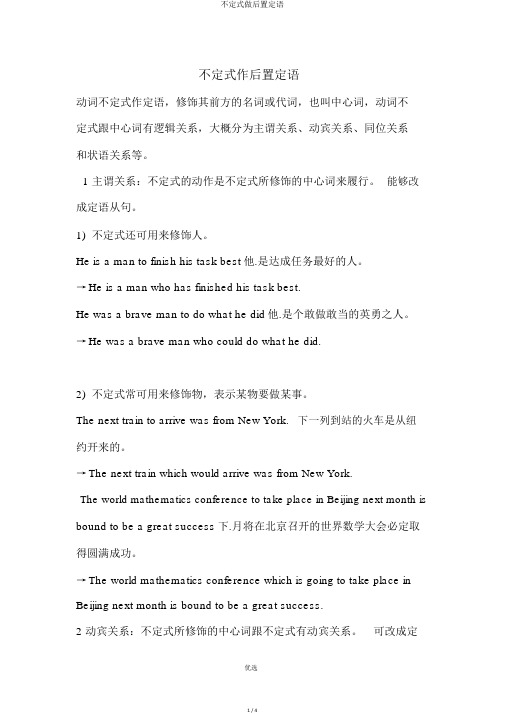
不定式作后置定语动词不定式作定语,修饰其前方的名词或代词,也叫中心词,动词不定式跟中心词有逻辑关系,大概分为主谓关系、动宾关系、同位关系和状语关系等。
1 主谓关系:不定式的动作是不定式所修饰的中心词来履行。
能够改成定语从句。
1)不定式还可用来修饰人。
He is a man to finish his task best他.是达成任务最好的人。
→He is a man who has finished his task best.He was a brave man to do what he did他.是个敢做敢当的英勇之人。
→He was a brave man who could do what he did.2)不定式常可用来修饰物,表示某物要做某事。
The next train to arrive was from New York.下一列到站的火车是从纽约开来的。
→The next train which would arrive was from New York.The world mathematics conference to take place in Beijing next month is bound to be a great success下.月将在北京召开的世界数学大会必定取得圆满成功。
→The world mathematics conference which is going to take place in Beijing next month is bound to be a great success.2 动宾关系:不定式所修饰的中心词跟不定式有动宾关系。
可改成定语从句。
跟主谓关系同样,不定式修饰的既能够是人,也能够是物。
不定式动作的履行者可能是句子的主语,也有可能是句子的宾语;有时不定式动作的执行者暗含在上下文中;有时用for somebody/something指出动作的履行者;有时根本不知道是谁。
不定式作定语的用法

不定式作定语的用法不定式及其短语作定语,与其他短语作定语一样,一般都放在被修饰的词之后,通常表示一个将来的动作,有时也可以表示某一过去的特定动作。
一些名词后常用不定式作定语,如:chance(机会),way(方法),time(时间)等;另外,the first,the second,the last,the only等作名词或者它们作形容词用来修饰代词,它们或它们所修饰的代词后,也常用不定式作定语。
不定式作定语时,不定式与被修饰词之间存在的关系复杂,有的是主谓关系;有的是动宾关系;有的是动状关系,还有的不存在主谓、动宾、动状关系。
1、主谓关系的(1)We must find a person to do the work.(2) There is no one to take care of her.(3) In my family,my mother is always the first one to get up.(4) He is always the first to come and the last to leave.(5) We need someone to go and get a doctor.2、动宾关系的如果不定式与被修饰的词在逻辑上存在动宾关系,不定式里的动词必须是及物动词。
注意:是及物动词的,后面不要再加宾语,因为前面的被修饰词是它的宾语;是不及物动词的,要加上适当的介词或副词让它变成及物动词,只有这样,它才能带上前面的宾语。
(1) He has a lot of books to read.(2) I would like a magazine to look at.(3) Here is some advice for you to follow.(4) Do you have anything else to say?(5) There is no one to take care of.(6) She has nothing to worry about.3、动状关系的被修饰词如果是不定式里动词的状语,应多用介词短语。
不定式作定语的用法

不定式作定语的用法不定式及其短语作定语,与其余短语作定语同样,一般都放在被修饰的词以后,往常表示一个未来的动作,有时也能够表示某一过去的特定动作。
一些名词后常用不定式作定语,如:chance(时机), way(方法), time( 时间)等;此外, the first,the second,the last,the only 等作名词或许它们作形容词用来修饰代词,它们或它们所修饰的代词后,也常用不定式作定语。
不定式作定语时,不定式与被修饰词之间存在的关系复杂,有的是主谓关系;有的是动宾关系;有的是动状关系,还有的不存在主谓、动宾、动状关系。
1、主谓关系的(1)We must find a person to do the work.(2)There is no one to take care of her.(3)In my family,my mother is always the first one to get up.(5)We need someone to go and get a doctor.2、动宾关系的假如不定式与被修饰的词在逻辑上存在动宾关系,不定式里的动词一定是及物动词。
注意:是及物动词的,后边不要再加宾语,因为前面的被修饰词是它的宾语;是不及物动词的,要加上适合的介词或副词让它变为及物动词,只有这样,它才能带上前面的宾语。
(1)He has a lot of books to read.(2)I would like a magazine to look at.(3)Here is some advice for you to follow.(4)Do you have anything else to say?(5)There is no one to take care of.(6)She has nothing to worry about.3、动状关系的被修饰词假如是不定式里动词的状语,应多用介词短语。
- 1、下载文档前请自行甄别文档内容的完整性,平台不提供额外的编辑、内容补充、找答案等附加服务。
- 2、"仅部分预览"的文档,不可在线预览部分如存在完整性等问题,可反馈申请退款(可完整预览的文档不适用该条件!)。
- 3、如文档侵犯您的权益,请联系客服反馈,我们会尽快为您处理(人工客服工作时间:9:00-18:30)。
不定式作定语
不定式作定语,一般都是作后置定语,修饰前面的名词或代词。
一、不定式与所修饰词之间的关系
1. 主谓关系
被修饰的名词或代词实际上是不定式的逻辑主语。
如:
We need someone to help with the work. (someone will help with the work)我们需要有人来帮忙干这工作。
2. 动宾关系
被修饰的名词或代词是动词不定式的逻辑宾语。
如:
I have many letters to write. (to write many letters)我有许多信要写。
3. 同位关系
不定式与所修饰的名词指的是一回事。
如:
We have made a plan to learn from Lei Feng. 我们制定了一个向雷锋学习的计划。
4. 状语关系
被修饰的名词实际上表示动词不定式动作的方式、时间等。
这些名词多是抽象名词。
如:That's the way to do it. 那样做才对。
I have no time to go there. 我没有时间去那儿。
二、不定式与其所修饰的词构成逻辑上的动宾关系,而该不定式为不及物动词时,其后须加上适当的介词,构成及物动词短语。
如:
I am looking for a room to live in. 我正在找一间屋子住。
I need a piece of paper to write on. 我需要一张写字用的纸。
There is nothing to worry about. 没什么可担心的。
不定式作定语且所修饰的名词是time,place或way时,不定式后的介词一般要省去。
如:He had no money and no place to live.他没有钱也没有地方住。
三、当不定式修饰的名词或代词为不定式动作的承受者时,不定式主动形式与被动形式的含义有所不同。
试对比:
There is nothing to do. 无事可做。
(有"无聊感")
There is nothing to be done. 不能做什么了。
(即"束手无策"了)
There is nothing to see. 没有东西值得看。
There is nothing to be seen. 什么东西也看不见。
一、不定式作定语
1.作定语的不定式如果是不及物动词,或者不定式所修饰的名词或代词是不定式动作的地点、工具等,不定式后面须有相应的介词。
如:
The Browns have a comfortable house to live in.
There is nothing to worry about.
Please give me a knife to cut with.
Here is some paper for you to write on.
但是,不定式所修饰的名词如果是time, place 或way时,不定式后面的介词习惯上省去。
如:He had no money and no place to live (in).
We found a way to solve this problem (in).
2.当作定语的不定式所修饰的名词或代词是不定式动作的承受者时,不定式既可以用主动语态,也可用被动语态,但其含义有所不同。
试比较:
Have you anything to send ? 你有什么东西要寄吗?(不定式to send 的动作执行者是“你”)
Have you anything to be sent ? 你有什么要(我或别人)寄的东西吗?
(不定式to be sent 的动作执行者是“我”或“别人”)
3.用不定式作定语的几种情况:
不定式表将来:
I borrowed some books to read during my holiday.
用来修饰被序数词、最高级或no, all, any 等限定的中心词。
如:
He was the best man to do the job.
He was always the first to come and the last to leave.
She was the first woman to win the gold medal in the Olympic Games.
Women and children were the first to get into the lifeboats.
用来修饰的词是抽象名词时,常见的有:ability, chance, idea, fact, excuse, promise, answer, reply, attempt, belief, way, reason, moment, time 等。
如:
Do you have the ability to read and write English ?
I have a chance to go sight –seeing.
动词不定式作定语与被修饰的词之间有一定的逻辑关系。
这些关系常见的有三种。
1、不定式与被修饰的名词或代词有逻辑上的动宾关系。
He told me he had a composition to write.
I want to get something to drink.
由上述例句得知,此时的不定式必须是及物动词。
如果是不及物动词,其后就带一个结构或含义上所需要的介词。
如:
Will you please bring me a chair to sit on?
She has nothing to worry about.
2、不定式与被修饰的名词或不定代词有逻辑上的主谓关系。
如:
He was the last one to arrive.
Is there anyone to take care of the children.
例句中的不定式动作的逻辑主语分别是one和anyone。
此时的不定式在意义上相当于一个定语从句。
如:
Among the men to take part in the work(==Among the men who are to take part in the work),he is probably the most active.
3、不定式所修饰的词在意义上通常是用于不定式所做某种事情的。
如:
We have got a new way to kill field mice.
I think he will have a chance to go to his hometown.
可以看出,way是用来to kill field mice, chance是用来to go to his hometown。
因此,这种类型的不定式译法较灵活。
可译作“…的”或“来/去…”等。
如:
She has no time to see the film。
